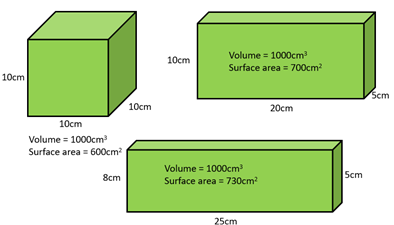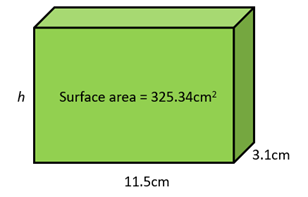Purpose
The purpose of this activity is to support students in measuring the volumes and surface areas of cuboids when the side lengths are given in decimal measurements.
Achievement Objectives
GM4-3: Use side or edge lengths to find the perimeters and areas of rectangles, parallelograms, and triangles and the volumes of cuboids.
Required Resource Materials
- Rulers
- Calculators
- A cardboard box with dimensions given in decimals numbers of centimetres. For example, a standard 1 litre carton measures 8.8cm x 5.9cm x 19.6cm.
- A variety of other cardboard boxes with dimensions given in decimals numbers of centimetres.
Activity
- Remind students how the volume (rōrahi) and surface area (horahanga mata) of a cuboid (poro-tapawhā hāngai) can be found using the dimensions (edge lengths).
What is the volume of the carton? (8.8 x 5.9 x 19.6 = 1017.632cm3).
What is the surface area of the carton)? (2 x (8.8 x 5.9 + 8.8 x 19.6 + 5.9 x 19.6) = 680.08cm2).
Why do you think these dimensions are chosen?
Look for students to comment that:
- the volume is slightly more than 1000cm3 (1 litre)
- the surface area cannot be too great
- the carton must be easy to hold.
- Provide the students with the other boxes.
Imagine you are advising the packaging company that makes these boxes. Calculate the volumes and surface areas of the boxes.
Could the dimensions of the cuboid change to reduce the surface area?
Could the box be more user friendly?
- Let the students work in pairs, organised to encourage tuakana-teina, to calculate the volume and surface area of each box. Roam as they work and look for students to:
- measure in decimal numbers of centimetres. This might include measuring in millimetres and then converting those measures to centimetres.
- use multiplication, and possibly a calculator, to find volume and surface area.
- express the measures using correct numbers and units, such as 624.6cm3 for volume and 564.8cm2 for surface area.
- At times during the investigation, you might gather the students to discuss important points, or ask students to discuss these points in pairs.
Interesting questions to discuss are:- Why do you think many boxes are smaller or larger copies of each other?
- What is the maximum volume of a cereal box that is customer friendly?
- What dimensions would minimise surface area and save on costs?
- Why are the dimensions usually not the best for minimising surface area?
Next steps
- Explore maximisation and minimisation problems. For example, Kiri boxes her homemade muesli to sell at the Farmers’ Market. She makes cuboid shaped boxes that hold 1000cm3 of muesli. What dimension will give her boxes the least surface area. Students might recognise that whilst the volume is constrained to 1000cm3, the dimensions, and therefore the surface area, might vary. The surface area is to be minimised. Students might also recognise that a cube has the least surface area for a given volume. Some examples of boxes with calculated volume and surface area are:

- Support students to solve problems where the volume or surface area is given in decimal amounts, but a decimal dimension (side length) is missing. For example:
What is h?
Add to plan
Level Four